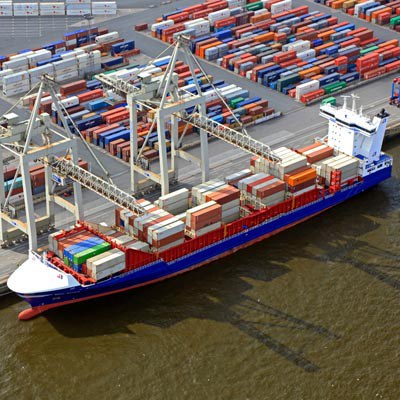Brandstwiete 1
20457 Hamburg

Thomas Crerar
Phone: +49 40 361 37 744
Fax: +49 40 361 37 204
Mail: thomas.crerar@bg-verkehr.de
Loading containers
- Packing and securing goods in containers
- Determining the gross mass of a packed container
- Questions and answers
Packing and securing goods in containers
A common scenario at home when you are about to go on a vacation: packing the car the right way requires some skill. The same applies to the loading of containers with goods. The interests of those involved in the packing process may differentiate: the charterer wants to accommodate as much cargo as possible; the shipowner is mostly interested in the compliance with the permissible total weight of the container. A wrong distribution of weight, missing securing of the load or an overloading of the container can not only lead to a damaging of the cargo but also endangers the stability of the ship itself. Wrongly stowed containers can go overboard during a storm – a high safety risk for maritime traffic since lost containers often swim just under the water’s surface which makes them hardly visible.
With the “Code of Practice for Packing of Cargo Transport Units”, in short CTU Code, the International Maritime Organization IMO, the International Labour Organization ILO and the United Nations Economic Commission for Europe UNECE adopted a guideline to practice safe loading of cargo transport units like containers. The CTU Code supports shipping companies and charterers in stowing and securing packing items. It documents up-to-date information on packing and securing cargo.
Further information about loading of containers is also available on the website www.containerhandbuch.de of the German marine insurers.

Determining the gross mass of a packed container
In January 2007 the container ship “MSC Napoli” was stranded off the coast of southern England. The salvage company had the containers weighed during the recovery. It transpired that many containers were considerably heavier than indicated in the cargo documents. One of the containers showed a weight difference of 20 tons.
Overloading containers poses a danger for the stability of ships and is therefore a big risk. That is why the International Maritime Organization IMO has included regulations for the weighing of containers in chapter VI Regulation 2 of the SOLAS Convention. The IMO provides further information on this topic on its website.
On the basis of these changes, the verified gross mass of a packed container that gets loaded onto a SOLAS ship has to be documented. Otherwise the packed container may not be loaded. The “Guidelines regarding the verified gross mass of a container carrying cargo” (MSC.1/Circ. 1475) specify the implementation of the SOLAS provisions.
In Germany, the Ship Safety Division of BG Verkehr is responsible for this topic.
These include:
- defining accuracy classes of the scales used for the determination of the gross mass and
- arrangement for the certification at the company if the gross mass is to be determined by calculation (so called method no. 2).
The BG Verkehr determined the following provisions in coordination with the European neighboring ports:
- If the whole packed container gets weighed (method no. 1), scales of accuracy class IIII (IV) or higher are to be used in accordance with Directive 2014/31/EC. Weighing on a chassis or trailer is generally possible. In this case, clause 11.1. of the Guidelines regarding the verified gross mass of a container carrying cargo (MSC.1/Circ. 1475) needs to be observed.
- If a shipper wants to determine the gross mass by calculating the individual components, he can ensure the certification with the existing certification (ISO, AEO) and by retaining already developed business processes. Weighing has to be done with scales of accuracy class III of Directive 2014/31/EC.
For shippers who do not have this option, BG Verkehr has developed an approved procedure to calculate the gross mass in accordance with Method 2.
TIn Germany, there is no special authorization procedures by BG Verkehr regarding either certification or the use of weighing devices.
Questions and answers
The followin FAQs elaborate on the different ways and requirements of the determination of the gross mass of containers.
Yes, clause 11.1 of the circular MSC.1/Circ.1475 is to be observed.
The application of Method No.2 is an alternative to weighing the packed container. Using the calculation method, the single masses of the cargo, dunnage and securing material as well as the tare of the container have to be added up.
Those who use this method must be certified for it. A current quality certification (e.g. ISO 9001, ISO 28001) or a recognition as AEO are sufficient. if the certified calculation method is included in the appropriate standards and provisions. A special certification for the determination of the gross ass of cargo containers is not required and there is also no additional approval procedure for the application of Method 2 in Germany.
For companies without a valid quality certification, Method 2 can be applied if the model procedure BG Verkehr has developed, is adhered to.
It is permissible to use manufacturer specifications about the single masses of packed cargo or dunnage and securing materials. It is however strongly advised to verify the specifications periodically by weighing oneself.
There are no objections to that. Only for certain cargo items, such as scrap and cargo in bulk, is Method No.2 inappropriate.
You can read the container’s net mass (tare) on the container door or copy it from a list provided by the shipping company, if applicable. This also applies when the weight of an empty container is given.
In Germany weighing instruments used for weighing packed containers have to be of accuracy class III (IV) of the EU Directive 2014/31/EC. When using Method No.2 weighing instruments of accuracy class III have to be used .
Verification is not a prerequisite for the use of weighing instruments for determining the gross mass of cargo containers. The weighing instruments have to be calibrated and certified. For different use, e.g. as public scales or to determine a price, an obligation to have the weighing instruments verified may apply based on verification regulation provisions. Before the acquisition of a weighing instrument, its purpose has to be thoroughly checked.
The gross mass has to be determined as accurately as possible. Tolerances are specified by the inaccuracies (maximum permissible errors in service) of the used weighing instrument.
The shipper has to work in accordance with the legislation of country A and based on SOLAS, i.e. he has to use calibrated weighing instruments of the accuracy specifications of country A and – when using Method No.2 – has to be certified in accordance with the regulation of country A. Country B has to consider the regulations in place in country A during any inspections.
The verified gross mass has to be documented by the shipper in the shipping documents. The document can be part of the shipping instructions to the shipping company or a separate communication. The documentation can also happen electronically. In any case, it has to be signed by a person authorized by the shipper. When electronic transmission is used, the signature may be made with simple electronic signature. SOLAS VI/2: “Reference to documents in this regulation does not preclude the use of electronic data processing (EDP) and electronic data interchange (EDI) transmission techniques as an aid to paper documentation.”
The transmission of the verified gross mass to the shipping company has to be sufficiently in advance to leave enough time to prepare a proper ship stowage plan. This can vary depending on the shipping company and is to a large extent dependent on the individual size of the ship. Therefore, what exactly “sufficiently in advance” means is determined by the shipping company. Public authorities will not set any provisions regarding this.
Random checks are done of the ship stowage plans regarding the loading ban of containers without declaration of the verified gross mass.
The container may not be loaded and is left at its current place.

